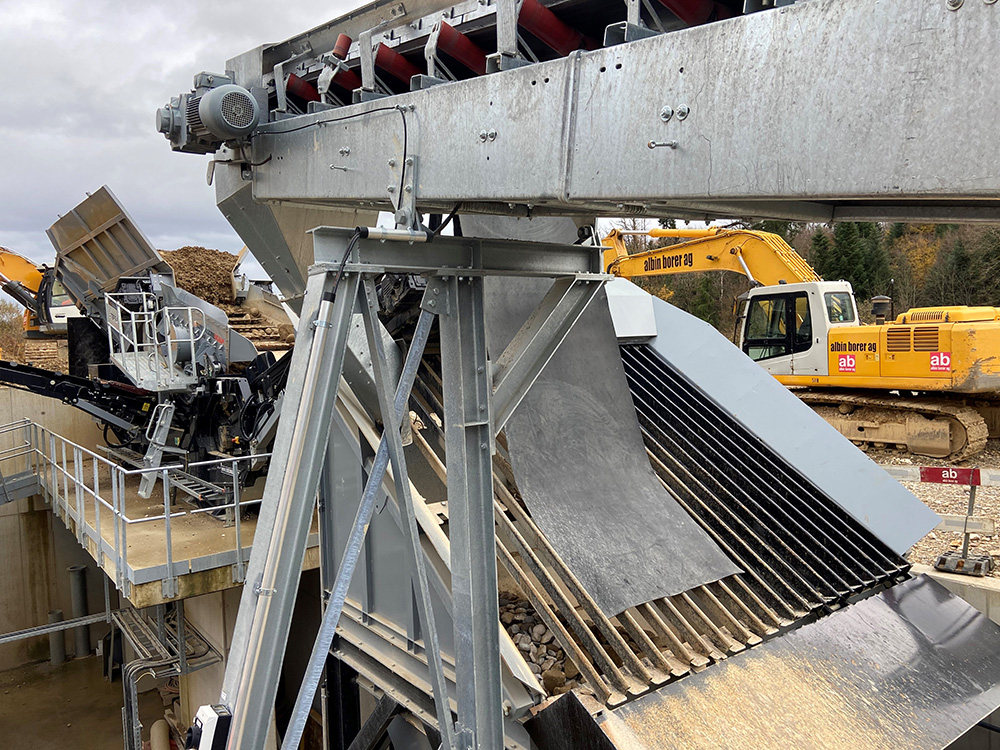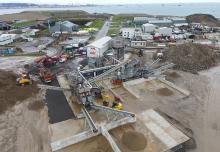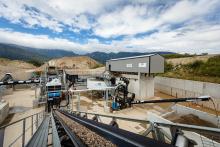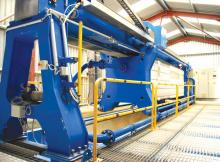
When a Swiss customer needed an end-to-end excavation wash recycling system for its DORO site in DIttingen, a municipality in the district of Laufen in the canton of Basel-Landschaft, Terex Washing Systems and its dealer, Avesco, answered the call.
With thousands of tonnes of construction and demolition (C&D) and excavation waste being stockpiled each year, a system that can recycle this waste into a saleable product has environmental as well as financial benefits to aggregates producers. It is exactly the solution Albin Borer AG, a Swiss Group in construction, infrastructure and material treatment, had been seeking when they began to investigate a way to recycle the waste they were sending to landfill.

Terex Washing Systems (Terex WS) was tasked with finding a solution to this problem for this customer, which resulted in the design, manufacture and installation of a complete end-to-end excavation wash recycling system. Everything from the feeder to the filterpress was included in the resulting installation, which manages to achieve throughputs of 250 tonnes per hour (tph) of C&D and excavation waste, producing nine saleable products. The close working relationship between Albin Borer AG, Avesco and Terex WS, along with a high level of aftersales support, has led to this bespoke project being commissioned successfully.
Albin Borer AG is an independent, family-owned company, that has been in business since 1932. It is a strong, future-oriented business that provides high-quality products for infrastructure and roads, concentrating its strengths on a wide range of construction industry services. From its locations in Erschwil, Laufen, Bolligen and Basel, the company operates in the cantons of Solothurn, Aargau, Bern, Jura and Basel. Many family members are still very active in the company and are part of the innovative advancements it has made over decades.
Albin Borer AG wanted to start processing its own waste material that was accumulating from infrastructure work that was happening in the region. Ultimately, the business wanted to generate a saleable product and open up a new revenue stream.
A major part of the overall Terex WS plant design was based on high capacity on a small footprint, due to site space restrictions. In addition, there was not a lot of water available on the site, coupled with environmental legislation around water use, which demanded additional design expertise from Terex WS for the final solution. The state-of-the-art Terex WS washing solution, which ensures that 95% of the water is recycled and reused within the wash plant, was achieved by the innovation team of applications and engineers at Terex WS in partnership with Avesco. The resulting full ‘feeder to filterpress’ solution also incorporates crushing capability from fellow Terex Materials Processing brand Terex Mineral Processing Systems (Terex MPS), as well as Terex WS’s AquaClear full water treatment solution. AquaClear features a Terex-designed and -manufactured filterpress with the capability of processing 250tph of feed material, and the ability to process 25 tonnes of sludge/final waste per hour.
Terex WS and Avesco continue to provide 24/7 aftercare support to Albin Borer AG as and when it may be required.

The feed material entering the comprehensive Terex WS plant is made up of excavation from various Albin Borer AG businesses. An AggreScalp 125 receives feed material from the loading shovel and removes oversized stones (larger than 150mm) from the material, which is achieved by the 150mm gaps in the finger bars installed. These oversized stones are stockpiled for later use. Medium-sized stones 150/80mm are sent via a side chute into a feed hopper, feeding the Terex MPS HSI 3434 horizontal shaft impactor. Since occasional pieces of metal were present within the feed material, an over-band magnet has been installed after each of the feed hoppers.
Out of the Terex MPS HSI impact crusher, the crushed stones are either passed to a dedicated stockpile, a dry 0-40mm stockpile, or onto the main conveyor sending the raw material to the washing plant.
After oversized stone and any metals are removed from the feed material, it makes its way up the main conveyor and enters into a Terex 20 x 6 (6m x 1.80m) three-deck rinsing screen. This 20 x 6 ‘pre-screen’ Rinser gives the material an initial wash before the various fractions are split with different apertures on the screen mats. The sand (0-4mm) and water from the rinsing screen pass to the ‘Prewash’ tank. The Terex WS Pre Wash has novel design features which allow the operator to process difficult or dirty material and ensures the production of sand products that conform to strict specifications.
The four 4-80mm aggregrate fractions pass into the new Terex-patented HydroScrub logwasher.
This HydroScrub is a unique design logwasher for aggregates scrubbing, patented by Terex, which allows operators to hydraulically adjust the hull angle from 9° to 16°, depending on the raw material to be treated. This gives the operator the ability to process a wider range of feed materials and is ideally suited for recycling applications.
If the raw material is containing a lot of light-density contaminants like wood, roots, plastics etc, the angle is set up high, and floating elements are easily removed. Likewise, if the raw material is containing more clay conglomerates, then the angle is set low, which results in better stone-on-stone scrubbing giving better throughputs and a cleaner aggregates product and eliminating the need for secondary scrubbing on high clay bound or dirty material.
The post-screen of the HydroScrub classifies the material into two different sizes - 4-40mm and 40-80mm. The 40 -80mm can be sent back to the crusher, or it can be sent to the dry classifying screen. The 4-40mm is also conveyed to the set of dry screens.
The water that has washed the aggregates up until this point in the process, along with the sand, is collected in the Terex WS PreWash tank. This unique solution is receiving all of the process water from the upstream process, with the sand, extra fines, clay, contaminants, and light-density particles.
The Terex WS PreWash tank allows the ability to produce sand products to the required specification from materials with high silt content. It is a must for recycling applications and plant operators. The principle of it is to pump less volume out than is entering the tank. It is designed to ‘overflow’ gently, separating out extra fines and the light density contaminants, keeping only the sand 0-4mm. This is then sent by a centrifugal pump to the sand-washing Hydro-cyclones module.
The Terex WS FM200 Sand Plant is part of the wider solution, and it is fitted with separators, high-performance cyclones, which are also specially designed for recycling applications. The use of separators means the plant can handle the variability of material that is often the case with construction, demolition and excavation material and results in a reduction in losses of valuable sand product, and the production of an in-specification material.

The FM200 also features a double-wash process. The Terex WS double-wash process ensures maximum recovery of sand through the removal of silt, slimes and clays below 63μm. The sand slurry (0-4mm and water) is pumped to the primary separator for an initial wash. The underflow discharges onto the dewatering screen, where it receives a further rinse. Any fine sand which passes through the screen is collected in the sump and pumped to the secondary separator for a final wash. It was necessary to double wash the material at the Albin Borer AG site due to the high percentage passing 63-micron in the feed, which was identified in the initial laboratory testing.
After this double-wash process, the two specification grades of sand are dewatered onto the high-frequency dewatering screen, which reduces residual water content in the final product to 10-15%. The water from both separators containing the minus 63-micron material is collected in a ground sump and pumped into the thickener tank—where the water-management process begins.
The wastewater is pumped into a low-level thickener with flocculent added, from the central control room housing unit. Within the low-level thickener, the waste particles of silt (minus 63-micron) and clay combine with the co-polymer, or flocculent, to create a larger, heavier particle that sinks towards the base of the cone. The flocculent dramatically speeds this process up and allows the clean water to pass over the top weir of the thickener into a collection tank, where it is recycled back into the wash plant.
The sludge that has been collected at the bottom of the deep cone thickener is pumped into a buffer tank, where it is stored until enough volume is gathered. At this point, it is transferred into a filterpress. The filterpress on this Albin Borer site is the Terex WS 165 plate press, with a plate size of 2m x 2m. The function of the press is to recover the last remaining water within the thickened sludge.
The filterpress has a working pressure of 16 bar (232psi). Each plate is covered in a nylon filter cloth, which, when filled with sludge under pressure, forces the remaining water to be removed from the sludge. This water is then recycled back into the wash plant to be used for washing aggregates and sand once again.
After the water has been removed from the sludge, bomb doors below the filterpress open, and the hydraulic ram begins to decompress. The slurry cakes are then rapidly discharged into the bay below the filterpress. Particularly sticky cakes are removed with a pneumatic plate shaker that ensures all the plates are ready for the next cycle. The cakes below can then be re-used for several applications, such as lining for ponds.
Albin Borer AG opted for an automatic cloth-wash system on their filterpress so that the lifespan of the filter cloths could be extended while optimum performance is ensured. This system cleans each cloth individually using a high-pressure water jet.
Johnston Patterson, product & applications manager at Terex WS, explained: “This wate-management system recycles 95% of the water used for this application. Albin Borer AG only needs a small tank of water to top up the system every so often. This has a hugely positive impact on the environment and has financial benefits.”
The result for Albin Borer is the sustainable production of usable and saleable sand and aggregates product from C&D and excavation waste. This also has the environmental benefit of being diverted from landfill. Additionally, the water-management products recycle the dirty water from the process and return clean water back to the process again for use.

Patterson added: “The customer is very pleased to have a solution in place to recycle their C&D and excavation waste. The working relationship between Terex Washing Systems, Avesco and Albin Borer AG has played a huge part in achieving a high level of performance for this plant.”
CDE is primed for growth in North America as the region’s customers increasingly look to turn dirt into dollars.
With 30 years of experience providing optimised, proven solutions to customers worldwide, Cookstown, Northern Ireland-headquartered CDE’s technologies have successfully diverted more than 100 million tonnes of CD&E waste from landfills, while turning construction, demolition and excavation (CD&E) materials into high-specification outputs.
The company’s AggMax scrubbing and attrition system, its Counter Flow Classification Unit (CFCU) for density separation and the EvoWash sand classification and dewatering system are among its proven plant solutions.
“We all understand that the depletion of natural aggregates is happening at a rate that is pretty scary. CDE has proven solutions that will slow that consumption of materials,” said Darren Eastwood, business development director at CDE, during CDE’s CONEXPO/CON-AGG 2023 press conference.
“We’ve been proving our solutions for the past 20 years, and in the last number of years, have brought them to the US and Canadian market. The recycling of inert and contaminated construction, demolition and excavation wastes can make a big difference to the construction industry across those countries, easing the pressure on landfills. It also eases the pressure on the trucking industry, which is often having to shift materials over long distances into cities. Most importantly, it eases the pressure on existing quarries and the valuable precious material that they have. We can also keep required material as close to the demand centre as possible.”
Eastwood said CDE’s two latest US customer recycling plants have gone live in California and Pennsylvania. The California plant is the first CDE sale in the Golden State. It will treat and process a variety of construction and demolition wastes. “This will make a big difference to the circular economy there. It will produce dependable recycled products for surrounding cities while doing away with the need for excessive long-distance trucked-materials supply. It will also have a big impact in lowering the cost per tonne of production and in the gas trucks need to use.
“The Pennsylvania facility is a stone’s throw from a city centre. It will be producing C33 [product] and a range of aggregates.”
At CONEXPO/CON-AGG 2023, CDE also unveiled its new P2-168 Infinity screen. With a processing capacity of up to 700 tons per hour, it's the largest model in CDE's range and has been designed specifically for the US market.
Matec Industries (Matec) will be opening a new factory in June to produce its massive Twin Freccia Rossa, the world’s biggest filter press.
The new factory is in Mulazzo, in the Italian region of Massa-Carrara, North Tuscany. It will be the sole production facility for the 50-metre-long, 600 tonnes per hour Twin Freccia Rossa.
The filter press is designed to combine the efficiency of two machines into a single product, offering faster sludge feeding and cake-discharge time.
Speaking at CONEXPO/CON-AGG 2023, Matec marketing manager Tatiana Bini said the company is taking on 60-70 new employees to work at the new factory in its offices and workshop.

"We are opening the new factory as we have had a lot of new orders and need to increase production," she added.
Italy-based Matec will now have three manufacturing bases. In addition to the new factory, Matec recently acquired the Alfa Pompe factory in Verona and has a manufacturing facility for small and medium machines at its headquarters in the town of Massa which is also in the Massa-Carrara province.
The Twin Freccia Rossa was first unveiled at the bauma trade show in Munich, Germany, in October 2022.
MWS Equipment, one of five McCloskey International business group brands under parent company Metso Outotec, is incorporating Metso Outotec pumps and cyclones into its machines - an industry-first pairing within the sand and aggregates processing industry that will bring new levels of efficiency to MWS Equipment’s product range. On display at the recent CONEXPO/CON-AGG 2023 exhibition in Las Vegas (14-18 March) were the MR200E Pump and the 650 Cyclone.
“A key focus is to expand the business’s [market] coverage, with more distributors coming from North America, Europe, and Asia-Pacific,” said Niko Lamminmäki, director of MWS Equipment and McCloskey Environmental. “We are also using different sales channels. In India and Norway, for example, we are using Metso Outotec direct sales teams, who have a strong foothold in those countries. We also manufacture our washing equipment in India [at the Metso Outotec facility in Alwar, Rajasthan].”









